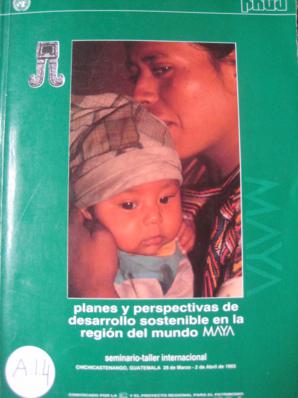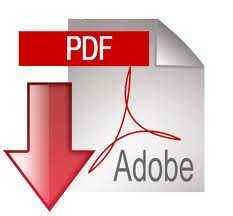A.15.1(a) Planes y Perspectivas de Desarrollo Sostenible en la Región del Mundo Maya. Seminario- Taller Internacional. Chichicastenango, Guatemala
A.15.1(b) Plans and Prospects for Sustainable Development in the Maya Region.
International Seminar /Workshop, Chichicastenango, Guatemala
 |
This publication is a compendium of articles on the Maya region from experts on cultural identity, education for all, human development, environment and ecology, cultural and natural heritage, and ecotourism and cultural tourism. Experts came from Belize, Canada, Costa Rica, El Salvador, France, Guatemala, Honduras, Mexico and the United States, along United Nations agencies UNDP, UNEP, UNESCO, UNHCR, UNICEF, UNFPA, UNIFEM, ILO, and international Banks, IADB, BCIE and non-governmental organisations such as Consejo de la Tierra, Unión Internacional para la Conservación de la Naturaleza, and Centro Mesoamericano para el Estudio de Tecnologías Apropiadas were also in attendance. Key speakers presented academic and substantive-practitioners’ papers on the Maya region. A written message was delivered to the encounter by Mrs. Rigoberta Menchú, Nobel Peace Prize 1992 laureate, which is included in the publication in full. Likewise, inaugural speeches by Henri Lopes (assistant director general of Culture for Unesco), Eunice Lima, (Minister of Culture of Guatemala), Anaisabel Prera Flores (vice-president of the Executive Board of Unesco), Bruno Guandalini (resident representative of UNDP), and Diego Xilox Saqic (vice-president of the Asociación de Artesanos de Guatemala) are reproduced in full.
By sustainable human development we mean a lasting, participatory process, developed and determined by the communities and groups involved in it. Thus it is appropriate to talk of a lasting self-development, and to insist on the need for a new definition of development focussing on the human dimension.
The Maya region is geographically, socially and culturally heterogeneous. It is not limited to the former habitat of the Mayas, it does not include all the descendants of that millennial civilization, not is it confined to them. Moreover, any development project implemented in the area will have to have an impact on the Mestizo and Amerindian populations that live in or around it. Sustainable human development in the Maya region must not be limited to terms that are in fashion or to mechanisms for getting rid of guilt feelings. Rather, it must be the framework that guides efforts to address material and spiritual needs defined by the people of the Maya region. The different peoples must have the opportunity to expressing their own interpretation of development, and determining ways of achieving it.
Local communities do not have all technical and financial resources required to satisfy these needs. The presence of external agents-such as governments, financial organizations and international institutions-is therefore necessary. However, they must have in-depth knowledge of the demands, interests and aspirations of the local Mayan and non-Mayan peoples—in order to satisfy these demands without contradicting and violating their cultural parameters or ways of life.
En español: El desarollo humano sostenible se entiende como un proceso duradero, participativo, generando y determinado por las comunidades y grupos potencialmente involucrados. Por ello, es conveniente hablar de autodesarrollo duradero e insistir en que urge una nueva definición de desarrollo que privilegie la dimensión humana.
La región del Mundo Maya es un espacio heterogéneo desde el punto de ista geográfico, social y cultural: no abarca sólo el antiguo hábitat de los mayas, no contiene a todos los descendientes de esa civilización milenaria y en la actualidad no se circunscribe únicamente a pueblos de filiación maya. Ademas, cualquier plan o proyecto de desarrollo ejecutado en la misma, habrá de impactar necesariamente a poblaciones mestizas e indoamericanas situadas en sus periferias o en su interior.
El desarrollo humano sostenible en la región maya no debe significar la circunscripción a una terminología en boga o un subterfugio para aliviar sentimientos de culpa. Como concepto metodológico, debe ser el marco que oriente el trabajo destinado a responder a las necesidades materiales y espirituales definidas por la población regional. Los pueblos, en efecto, deben tener la posibilidad de expresar su interpretación del desarrollo y de determinar la forma de lograrlo.
Las acciones técnicas y financieras para lograr la solución o satisfacción de tales necesidades rebasan el marco local, haciendo obligatoria la presencia de agentes externos tales como instancias de gobierno, organismos financieros e instituciones internacionales. Es imprescindible que tales agentes conozcan en profundidad las demandas, intereses y aspiraciones de los pueblos mayas y no-mayas para satisfacerlas sin contradecir y violentar sus parámetros culturales y ritmos o formas de vida.
Author(s): Sylvio S. Mutal (NL), Cojtí Cuxil (Gua), Gloria Lara Pinto (Hon), Alfredo César Dachary (Gua), Sylvain Laurié (Fr), Enrique Ku Herrera (Gua), Andrés Cuz Mucú (Gua), Marcelino Nicolás Moscut (Gua), Mario Humberto Ruz (Gua), Rubén Surec (Gua), Sarah Timpson (UNDP, USA), Hugo Navajas (Bol), Arturo Gómez-Pampa (Gua), John Celecia (Arg), Roberto Morales Juárez (Mex), José Us Vicente (Gua), Ricardo Agurcia (Gua), Winnel Branche (Bel), María Isaura Arauz (SAL), Héctor Arena (UNESCO, Arg), María Elena Molina (Gua), Claudia Arenas Bianchi (It), María Eugenia Bacci (Ven), Claude Moulin (Fr), Roberto Godoy (Mex), Norman Lippman (USA), Bill Garrett (USA)
Introduction: S. Mutal (ATP/ Coordinador Regional RLA-ALC PNUD/Unesco)
Published in 1993, 267 pag., Spanish, introduction and summary also in English, illustrated
RLA (UNDP/Unesco) in collaboration with: Ministerio de Cultura de Guatemala

188 MB
|
|





